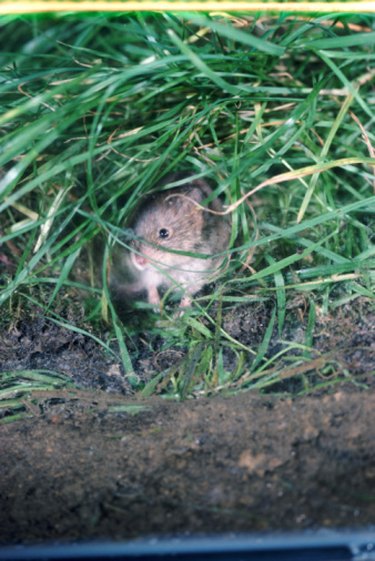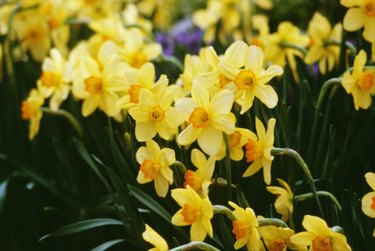
Voles, small furry animals that resemble mice with shorter tails, can pose a real problem when they invade your yard. Many times a method of removal, other than poison, will be sought out to protect pets, children and wildlife. Adding specific plants to your garden and yard landscape that voles will not eat will add a natural vole deterrent to your yard, eliminating the need for any poisons or pesticides.
Daffodils
Video of the Day

Voles often live underground during winter months and survive on vegetation, including roots from grass and flower bulbs. Daffodils contain a chemical toxic to herbivores, including voles. These alkaloid chemicals, found in each part of a daffodil, will work effectively to deter voles from hanging around your garden. Planting these bulbs in your garden, 6 to 12 inches apart, will keep voles away from your garden year-round, including the winter months when they seek underground vegetation.
Video of the Day
Ornamental Onions
Nearly any plant included in the onion family will work to effectively deter voles from eating your plants. Ornamental onions feature a chemical compound that causes other plant tissue to have a bad taste so the voles will avoid areas where ornamental onions grow. Ornamental onions add a unique splash of color and variety to your garden, enhancing the beauty of the area even if you do not choose to eat the onions yourself.
Mountain Mint
Commonly found in Illinois, mountain mint, although attractive to bees, flies, beetles and butterflies, features a scent that voles and other herbivores find repulsive. This perennial stands up to 3 feet in height and has a branchy appearance. If the foliage becomes damaged, a strong mint fragrance is released. This plant, easy to grow and hardy, may be subject to rust if the plant becomes stressed.
Sweet Goldenrod
Sweet goldenrod, although attractive to ladybugs and bees, remains a hardy perennial that voles avoid. This plant, typically found in dry, sandy soil, blooms during the latter part of the summer. Sweet goldenrod, one of 130 species of the goldenrod plant, is made into medication and teas. Most goldenrod features heavy pollen known to cause allergies.
Grape Hyacinth
Voles enjoying dining on bulbs, including tulips, but adding grape hyacinth bulbs to your flower garden will deter them from entering your garden and destroying other plants. When included in a garden featuring daffodils, you will ensure your plants' safety. Grape hyacinth rate at the top of the bulbs that voles show no interest in. They will stay away from your garden when you use grape hyacinth as a border plant. This method works effectively around your vegetable garden as well.
Crown Vetch
A member of the legume family, the crown vetch features a flavor not preferred by voles. When planted around orchards or used as boundaries, it will effectively control the vole population in the area. Crown vetch spreads quickly and will destroy other plants with its creeping stems that can grow up to 6 feet in length. If allowed to invade natural areas, it will climb trees, shrubs and other vegetation native to the area.